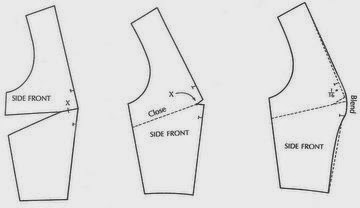Fashion Pattern
Part 2
Landmarks: Designated points (landmarks) around the body that correspond with those of the form. They are used for measuring the body sections when drafting and draping.
Dot mark: A pencil mark indicating a specific point on the pattern or muslin.
Example
A series of dot marks are connected to outline a shape or line on the pattern or muslin.
Pin marking: Placing a series of pins through the muslin or form to evaluate styleline placement.
Tape marking: Styleline placement by tape to evaluate design features, and to provide a guide when draping, or developing design patterns.
Trueing: The blending and straightening of pencil lines, crossmarks, and dot marks for the purpose of establishing correct seam lengths.
Example: Trueing side seam having a side dart.
Blend: A process of smoothing, shaping, and rounding angular lines along a seam for a smooth transition from one point to the next, and for equalizing the discrepancies of joining lines and marks made on the pattern or fabric (muslin).
Blending example
Bust Point: A designated placed on the bust and pattern.
Apex: The highest location of a mound.
Dart: A wedge-shape cutout in a pattern, used as means of controlling the fit of a garment.
Dart Legs: The two lines that form an open space at the pattern's edge and converge at a predetermined point on the patter.
Dart Intake: Amount of excess or space confined between dart legs to control the fit of the garment. It purpose is to take up excess where it is not needed, and gradually release fabric where it is needed.
Double-ended dart: Along vertical dart passing through garments having no waistline seam. The dart intake is controlled by two punches and circles placed at the center fold at waist level and 1/8 inch from one side of the dart leg, and 1/4 to 1/2 inch in from the dart at each end.
Uprighting a dart. Moving the dart point so that it takes places the center back or the center front of a garment.
Darts examples on garments.




































